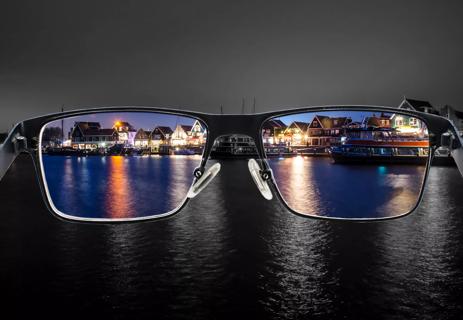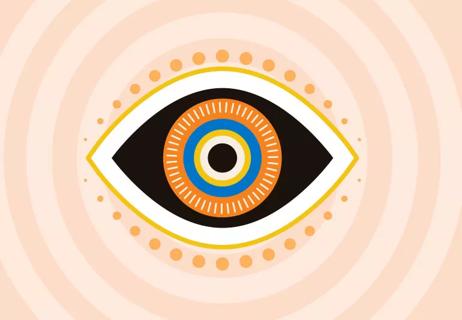Combat blurry night vision and see more clearly with these expert tips

Seeing clearly is necessary for safe driving. When part of your eye has an irregular curve (astigmatism), night driving can be difficult. Combine that condition with blinding glare from ongoing headlights and … well, it can lead to some nervous miles behind the wheel.
Advertisement
Cleveland Clinic is a non-profit academic medical center. Advertising on our site helps support our mission. We do not endorse non-Cleveland Clinic products or services. Policy
Astigmatism is common, affecting about 30% of people. Ophthalmologist Nicole Bajic, MD, explains how astigmatism affects night driving and what you can do to see better after dark.
Most people learn they have astigmatism when they see an eye specialist and receive a vision prescription. The condition occurs when part of your eye — usually the cornea — is oblong like a football instead of round, the ideal shape.
You can have some level of astigmatism even if you have perfect 20/20 vision, says Dr. Bajic. Symptoms of astigmatism include:
The best way to find out if you have astigmatism is to go for an eye exam. “Everyone over 40 should see an eye doctor every year,” says Dr. Bajic. “Changes in your eye occur as you age and distort your vision.”
Astigmatism can worsen as you age, too. Aging also means you’re more likely to develop common vision problems like cataracts — when the clear lens inside of your eye turns cloudy, contributing to night-driving issues.
The oblong shape of eyes with astigmatism distorts light, making you struggle to see when driving at night.
“It’s pretty common to see halos around lights while driving at night,” says Dr. Bajic. “But if you have significant astigmatism, the halos look more like comets with lines of light radiating out from the center.”
Advertisement
In addition to astigmatism, some people have night myopia, where their pupils naturally widen, or dilate, more at nighttime, says Dr. Bajic. This allows more light to enter your eyes.
With night myopia, your vision automatically worsens after dark, especially if you have a prescription and your glasses or contacts aren’t up to date. Night myopia also tends to occur in people with lighter-colored eyes.
The bottom line: “We all find those bright LED headlights obnoxious,” says Dr. Bajic. “But if you have significant astigmatism or cataracts, they’re really bothersome.”
Driving at night with astigmatism can be challenging. But you can lessen the blurring effects of the eye condition by taking these steps:
People sometimes wear contact lenses that don’t fully address their astigmatism. To correct the condition, you need toric contact lenses. They’re more expensive than regular contacts. But if you’re having vision problems at night, it’s essential to fix astigmatism.
Glasses are a good alternative to contacts because they’re easier to customize for astigmatism, says Dr. Bajic. You can use your glasses for night driving instead of investing in toric contacts.
Either way, the first step to better vision is making sure your prescription is up to date.
Cataracts develop gradually and usually start to affect your vision around age 60. When you have both cataracts and astigmatism, it doubles your trouble driving at night.
Cataract surgery removes cloudy lenses, replacing them with clear, artificial ones. This procedure improves your overall vision, including at night. Talk to your healthcare provider if you have cataract symptoms such as:
You can buy over-the-counter glasses specifically for night driving. To reduce glare, these inexpensive glasses feature yellow lenses to filter vision-blurring blue light. Some may also have an anti-reflective coating.
However, they don’t correct your vision and there’s no proof that they work.
“We don’t have a lot of research about their efficacy,” notes Dr. Bajic. “But many of my patients who’ve tried them found them useful. Most importantly, wearing night-driving glasses doesn’t do any harm. So, it’s fine to use them if you feel like it’s helping you be safer on the road.”
Laser vision correction surgery can improve both nearsightedness and farsightedness, but it worsens night vision for some people. The surgical alternative for people with astigmatism is toric lens implants, which correct astigmatism.
Advertisement
You can have a lens implant procedure at the same time as cataract surgery. During cataract surgery, your healthcare provider replaces your natural, cloudy lens with an artificial lens. Different artificial lenses are available to help correct vision, including toric ones for astigmatism.
While removing the cataract, your healthcare provider can replace your natural lens with a toric lens to correct astigmatism. This can help eliminate two major causes of poor night vision at once.
If you’re uncomfortable driving at night, a simple solution is to get behind the wheel only during the day. Or stick to familiar areas if you must go out in the evening. It’s not worth risking your safety or the safety of others to drive when you can’t see clearly.
Clenching the steering wheel and squinting your way down the street isn’t a safe way to drive. “If your vision is affecting your daily activities like driving at night, if it’s changed or become bothersome, get it checked out,” says Dr. Bajic.
Feeling confident cruising down the street after dark could be as easy as slipping on a new pair of glasses.
Advertisement
Learn more about our editorial process.
Advertisement

These trendy glasses might brighten some shades and help you see the difference between colors or brightness of hues, but they won’t cure your color vision deficiency

Some eye conditions can have more noticeable effects at night

Nonstop screen time can strain your eyes

Tips for protecting and preserving your eyesight

Find out exactly why too much screen time can lead to eye problems

If you’re feeling short of breath, sleep can be tough — propping yourself up or sleeping on your side may help

If you fear the unknown or find yourself needing reassurance often, you may identify with this attachment style

If you’re looking to boost your gut health, it’s better to get fiber from whole foods